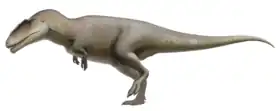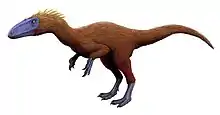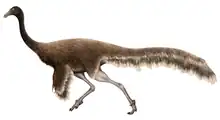Berthasaura
Berthasaura (meaning "Bertha's lizard") is a genus of noasaurid ceratosaurian theropod dinosaur from the Cretaceous Goio-Erê Formation of Paraná, Brazil. The type and only species is Berthasaura leopoldinae.[1]
| Berthasaura Temporal range: Early Cretaceous Possible Late Cretaceous record | |
|---|---|
 | |
| Skeletal diagram | |
| Scientific classification | |
| Domain: | Eukaryota |
| Kingdom: | Animalia |
| Phylum: | Chordata |
| Clade: | Dinosauria |
| Clade: | Saurischia |
| Clade: | Theropoda |
| Family: | †Noasauridae |
| Genus: | †Berthasaura de Souza et al., 2021 |
| Type species | |
| †Berthasaura leopoldinae de Souza et al., 2021 | |
Discovery and naming
Between 2011 and 2015, paleontologists working at the Cemitério dos Pterossauros site near Cruzeiro do Oeste discovered the skeletons of the pterosaurs Caiuajara and Keresdrakon as well as remains of small theropods. One of these was in 2019 named and described as Vespersaurus but a second species proved to be present.[1]
In 2021, the type species Berthasaura leopoldinae was named and described by Geovane Alves de Souza, Marina Bento Soares, Luiz Carlos Weinschütz, Everton Wilner, Ricardo Tadeu Lopes, Olga Maria Oliveira de Araújo and Alexander Wilhelm Armin Kellner. The generic name Berthasaura refers to the scientist and women's rights activist Bertha Maria Júlia Lutz, while the specific name honors Maria Leopoldina, the first Empress of Brazil; the bicentennial of Brazil's independence was in 2022, close to when the dinosaur was described. Indirectly this also refers to the Imperatriz Leopoldinense samba school; for the 2018 carnival, they developed the theme of Uma noite real no Museu Nacional (Portuguese: A real night in the National Museum); in September of that year a catastrophic fire would destroy much of its collection.[1]
Description

The holotype, MN 7821-V, is a nearly complete disarticulated skeleton excavated between 2011 and 2014 and is one of the most complete dinosaurs known from the Cretaceous Brazil, preserving the most complete axial series of any noasaurid known to date. Its toothless, short beak suggests it was a herbivore or at least an omnivore, unlike most other ceratosaurs except for adult Limusaurus. Because the holotype represents an immature individual, it has been suggested that Berthasaura was herbivorous throughout its entire life, unlike Limusaurus. It was probably less than 1 metre (3.3 ft) long.[1]
Classification
Berthasaura was placed by de Souza and colleagues as the basalmost noasaurid, distantly related to Limusaurus.[1]
| Ceratosauria |
| ||||||||||||||||||||||||||||||||||||||||||||||||||||||||||||||||||||||||
Paleoenvironment
Berthasaura lived in the Goio-Erê Formation, which was an ancient desert. Its dating is uncertain; de Souza and colleagues believe it was deposited during the Aptian-Albian, but a Late Cretaceous date has also been proposed.[2] Other animals recovered from this formation include the pterosaurs Caiuajara and Keresdrakon, as well as the lizard Gueragama.[3][2][4]
References
- de Souza GA, Soares MB, Weinschütz LC, Wilner E, Lopes RT, de Araújo OM, Kellner AW (2021). "The first edentulous ceratosaur from South America". Scientific Reports. 11 (1): Article number 22281. Bibcode:2021NatSR..1122281D. doi:10.1038/s41598-021-01312-4. PMC 8602317. PMID 34795306.
- Kellner, Alexander W. A.; Weinschütz, Luiz C.; Holgado, Borja; Bantim, Renan A. M.; Sayão, Juliana M. (19 August 2019). "A new toothless pterosaur (Pterodactyloidea) from Southern Brazil with insights into the paleoecology of a Cretaceous desert". Anais da Academia Brasileira de Ciências. 91 (suppl 2): e20190768. doi:10.1590/0001-3765201920190768. ISSN 0001-3765. PMID 31432888.
- Manzig, P.C.; Kellner, A.W.A.; Weinschütz, L.C.; Fragoso, C.E.; Vega, C.S.; Guimarães, G.B.; Godoy, L.C.; Liccardo, A.; Ricetti, J.H.C.; Moura, C.C. (2014). "Discovery of a Rare Pterosaur Bone Bed in a Cretaceous Desert with Insights on Ontogeny and Behavior of Flying Reptiles". PLOS ONE. 9 (8): e100005. Bibcode:2014PLoSO...9j0005M. doi:10.1371/journal.pone.0100005. PMC 4131874. PMID 25118592.
- Simões, Tiago R.; Wilner, Everton; Caldwell, Michael W.; Weinschütz, Luiz C.; Kellner, Alexander W. A. (26 August 2015). "A stem acrodontan lizard in the Cretaceous of Brazil revises early lizard evolution in Gondwana". Nature Communications. 6: 8149. Bibcode:2015NatCo...6.8149S. doi:10.1038/ncomms9149. PMC 4560825. PMID 26306778.

.jpg.webp)












